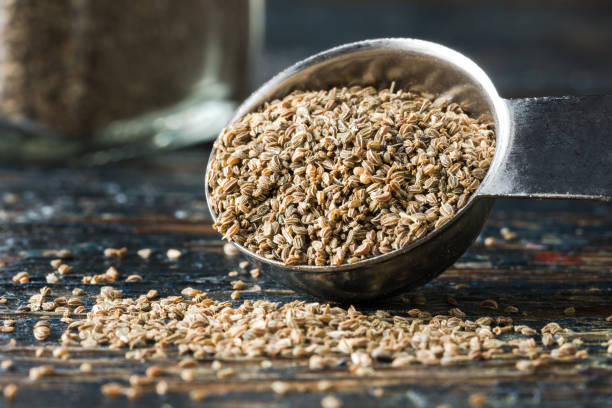Celery seeds are small, oval, and ridged seeds harvested from the celery plant. They are typically light brown to dark brown in color and have a strong, earthy, and slightly peppery aroma. The flavor is warm and aromatic, with a hint of bitterness and a savory, herbal taste, making them popular in a variety of culinary applications.
Celery seeds are commonly used in pickling, soups, stews, and salad dressings. They are also a key ingredient in spice blends such as celery salt. In addition to their culinary uses, celery seeds have been traditionally used in herbal medicine for their anti-inflammatory and digestive benefits.
Size and Shape: Celery seeds are small and oval, typically measuring about 2 to 3 mm in length. They have a slightly flattened, ribbed surface.
Color: The seeds are light to dark brown, with a rough texture that gives them a distinctive appearance.
Texture: The seeds are hard and smooth, with noticeable ridges along the surface, which are prominent when observed closely.
Aroma and Flavor: Celery seeds have a strong, earthy aroma with a slight peppery and herbal scent. The flavor is bold, savory, and slightly bitter, with a hint of anise-like flavor when crushed or ground.
These physical characteristics make celery seeds a versatile and aromatic addition to various culinary and medicinal uses
Celery seeds contain essential oils, with the most significant compounds being limonene, selinene, and phellandrene, which contribute to their distinct aroma and flavor.:
The seeds are rich in flavonoids, such as apigenin, which have antioxidant and anti-inflammatory properties.
Celery seeds contain essential fatty acids, including linoleic acid (omega-6) and oleic acid (omega-9), which are beneficial for overall healthy
Celery seeds provide small amounts of essential vitamins and minerals, including vitamin A, vitamin C, calcium, iron, and magnesium.
Celery seeds contain coumarin, a chemical compound known for its potential medicinal properties, including its ability to support digestion and reduce inflammation.
These chemical components contribute to the culinary and medicinal benefits of celery seeds, providing them with their unique flavor profile and potential health-promoting properties.
Nutritional Value (per 100 grams)
Calories: 276 kcal
Protein: 18.1 g
Total Fat: 22.8 g
Carbohydrates: 41.4 g
Dietary Fiber: 11.8 g
Sugars: 0.5 g
Vitamins: Vitamin A: 0 IU-Vitamin C: 17.2 mg-Vitamin K: 0.1 mcg-Folate (B9): 10 mcg
Minerals: Calcium: 1240 mg-Iron: 44.9 mg-Magnesium: 440 mg -Potassium: 1400 mg- Phosphorus: 547 mg
“Compliant with local and European standards according to food safety regulations.”
Seeds should be at least 99% pure, free from foreign matter, other crop seeds, and inert materials.
Maximum moisture content should be 10% to 12% to prevent spoilage and ensure long shelf life.
Seeds must have a uniform color, be clean, mature, and free from discoloration, mold, or damage.
Uniformity in seed size and shape is preferred for consistent quality and appearance.
Seeds should have a characteristic celery aroma and flavor, free from any off-odors or rancid smell.
Should not exceed 0.5%. This includes dust, dirt, stones, and plant debris.
Seeds must be free from live insects, insect fragments, and evidence of pest infestation.
Levels must be within internationally accepted limits, especially for food-grade seeds.
Seeds must meet food safety requirements for pathogens like Salmonella, E. coli, and yeast/mold count.
Seeds should be packed in clean, food-safe, and sealed containers, with proper labeling
1. Total Plate Count (TPC):
Should not exceed 1 × 10⁴ CFU/g – this measures the general microbial load and indicates overall hygiene during processing.
Should be less than 1 × 10³ CFU/g – high levels may indicate poor storage or contamination.
Should be minimal, generally <10 CFU/g, indicating good sanitary conditions.
Absent in 1g – presence indicates fecal contamination and is not acceptable in food-grade seeds.
Absent in 25g – a critical safety standard required for all food and export regulations.
Must be within internationally accepted limits, typically <10 ppb for total aflatoxins depending on the country’s regulations
https://www.researchgate.net/publication/373703812_Antimicrobial_Activity_of_Dill_Seeds_and_Celery_Seeds_on_Beef_BurgerPackaging and Storage :
As per the customer’s request, polypropylene bags and cartons.”
Temperature: Store in a cool and dry environment, ideally between 15–20°C (59–68°F).
Humidity: Relative humidity should be kept below 60% to prevent mold and degradation.
Ventilation: Ensure proper air circulation in the storage area to avoid moisture buil
Under proper storage conditions—cool, dry, and airtight—celery seeds have a shelf life of 1 to 2 years. To maintain optimal flavor, aroma, and quality, it is best to store them away from direct sunlight, heat, and moisture. Using proper packaging and following FIFO (First In, First Out) practices can help ensure maximum freshness during this period.
Traceability and Compliance;
Origin :Egypt
Application:
Used as a spice in soups, stews, pickles, sauces, and salad dressings.
Ground celery seeds are a key ingredient in celery salt.
Common in seasoning blends for meats and vegetables.
Traditionally used to support digestion, reduce inflammation, and relieve joint pain.
Sometimes used as a diuretic to help reduce water retention
Celery seed oil is used in aromatherapy for its calming and detoxifying properties.
Added to massage oils and herbal preparations.
Found in capsule or extract form to support blood pressure regulation and uric acid control.
Occasionally used in natural skincare products due to its antimicrobial and anti-inflammatory compounds.
Celery seeds are valued for both their flavor and health-supporting properties across culinary, medicinal, and wellness applications.
Contact information:


